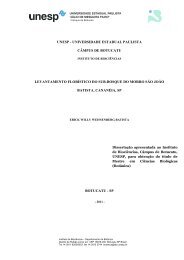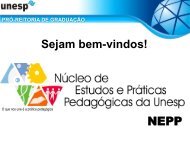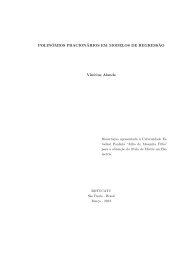Impactos de pisciculturas em tanques-rede sobre a ictiofauna da ...
Impactos de pisciculturas em tanques-rede sobre a ictiofauna da ...
Impactos de pisciculturas em tanques-rede sobre a ictiofauna da ...
You also want an ePaper? Increase the reach of your titles
YUMPU automatically turns print PDFs into web optimized ePapers that Google loves.
Abstract<br />
<strong>Impactos</strong> <strong>de</strong> <strong>pisciculturas</strong> <strong>em</strong> <strong>tanques</strong>-re<strong>de</strong> <strong>sobre</strong> a <strong>ictiofauna</strong> <strong>da</strong> represa <strong>de</strong> Chavantes:<br />
alimentação, parasitas e bromatologia - Autor: Igor Paiva Ramos<br />
Currently, the <strong>de</strong>ployment of fish farming in cages in Brazilian reservoirs is a source of<br />
negative impacts on water quality and biota. This activity acts as a secon<strong>da</strong>ry source of energy<br />
to the aquatic ecosyst<strong>em</strong>, such as ration wastes that attract adjacent biota, causing changes in<br />
the structure of local community. The aim of this study was to evaluate the influence of fish<br />
farming in cages on fish species attracted to these areas, focusing on biological features (diet,<br />
bromatology and parasitology) in a large <strong>da</strong>m in the middle Paranapan<strong>em</strong>a River. To this aim,<br />
it was used five fish species (Astyanax altiparanae, Galeocharax knerii, Iheringichthys<br />
labrosus, Pimelodus maculatus and Plagioscion squamosissimus). The specimens were<br />
captured with gill nets in areas around the cages (CF) and in areas without the influence of<br />
this type of activity (CT). It was characterized the diet for the five selected species,<br />
bromatological composition of the species G. knerii and P. maculatus, and the infection rate<br />
of metacercariae of Austrodiplostomum compactum in P. squamosissimus was assessed, being<br />
all comparative analysis between the CF and CT areas. The results show that there were<br />
significant changes in the diet of trophic generalist species (A. altiparanae, P. maculatus and<br />
I. labrosus) with consequent increase in condition factor values in the TR areas. Trophic<br />
specialist species, such as the carnivorous fish G. knerii and P. squamosissimus, showed small<br />
differences between CF and CT areas regarding diet, with no significant changes for other<br />
analyses performed. Concerning bromatological analysis, significantly higher values were<br />
observed (p 0.05) for P.<br />
maculatus. There were no differences (p> 0.05) between G. knerii specimens captured in the<br />
tank and control areas. Regarding parasitological aspects of P. squamosissimus, the mean<br />
intensity of infection (CF = 20.31 ± 1.13 / CT = 4.29 ± 7.14), prevalence (CF = 86.4% / CT =<br />
57.1%) and average abun<strong>da</strong>nce (CF = 17.70 ± 6.27 / CT = 2.35 ± 0.77) showed significantly<br />
higher values in the tank area comparing to control area (p
















